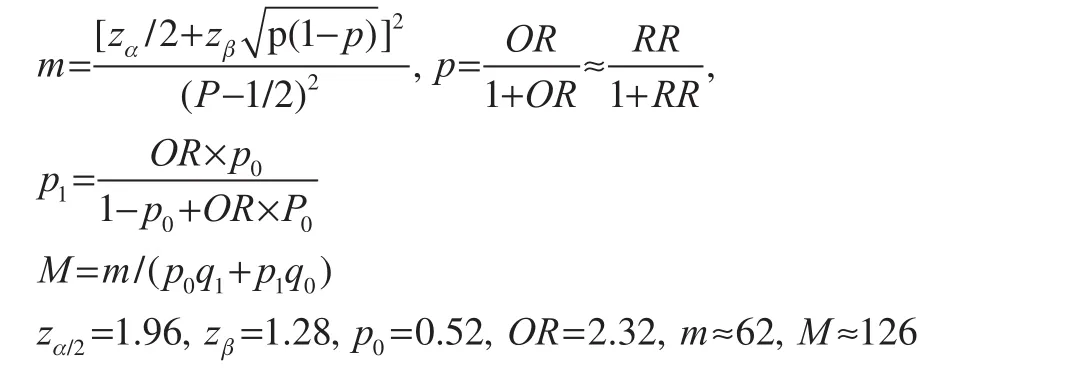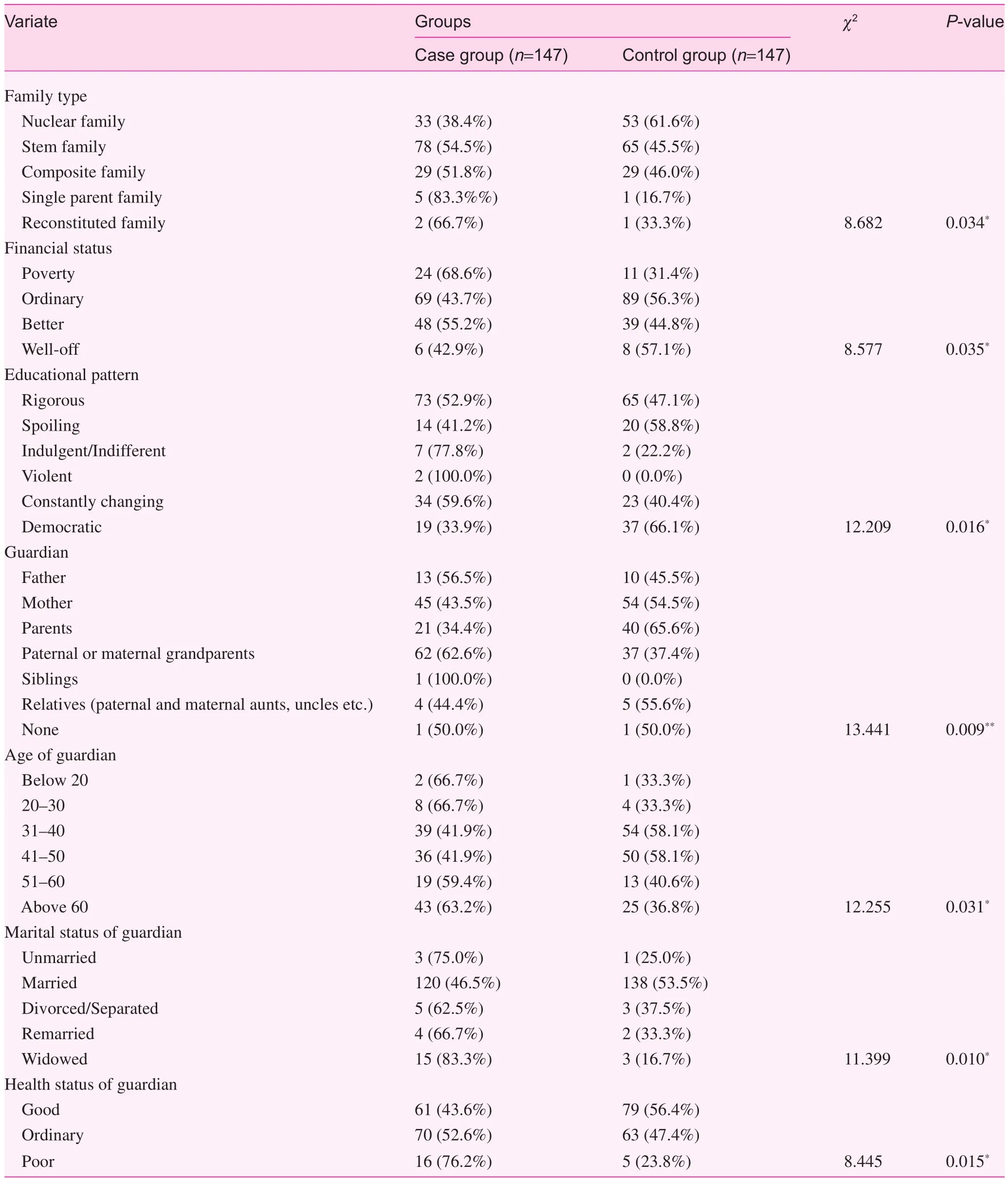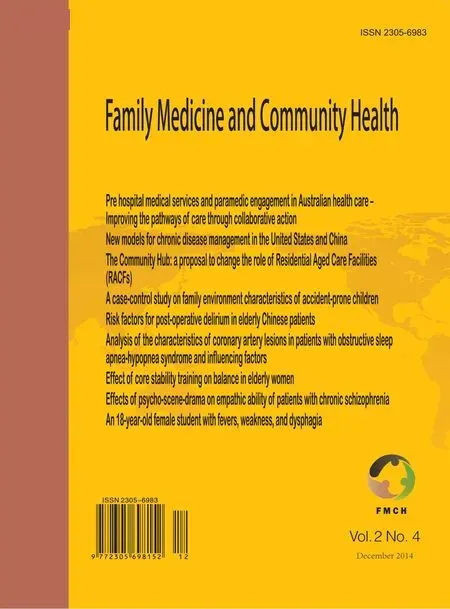A case-control study on family environment characteristics of accident-prone children
2014-09-25SisiChenLeshanZhou
Sisi Chen, Leshan Zhou
A case-control study on family environment characteristics of accident-prone children
Sisi Chen, Leshan Zhou
Objective:The purpose of the current study was to determine the family environment characteristics of accident-prone children, and the inf uencing factors to provide a reference for accident prevention and intervention for these children.
Methods:One hundred forty-seven cases of accident-prone children were screened out from a cross-sectional survey as the case group, and another 147 cases of non-accidentally-injured children served as the control group. The Chinese version of the Family Environment Scale (FES-CV) was applied to evaluate the family environment characteristics of subjects from both groups.
Results:The incidence of accident-prone children was 9.42%. Comparing the scores of all factors in the FES-CV, the contradiction score of the case group was higher than the control group, while the scores of other factors was lower than the control group. Differences between the two groups with respect to intimacy, emotional expression, contradiction, independence, and success scores were statistically signif cant, but differences in informative and entertaining scores were not. Differences with respect to family type, f nancial status, education, guardian, age of guardian, marital status, and health status were statistically signif cant. As revealed by regression analysis, intimacy (OR=0.530), emotional expression (OR=0.749), and independence (OR=0.732) were protective factors for accident proneness, while rigorous education (OR=2.101) and indulgence or indifference/violence (OR=7.629) were risk factors for accident proneness.
Conclusion:Family environment inf uence child accident proneness, thus preventive interventions should be provided according to the characteristics of the family environment.
Children, Accident proneness, Family environment
Introduction
Accident proneness is an individual characteristic which is relatively stable. The incidence of accidents is higher among those with higher accident proneness when exposed to the same risk factors, and such characteristics are innate and consistent [1]. Existing studies have observed multiple accidental injuries among a small number of children [2]. Currently, accident-prone children in China are those children who have undergone three or more accidental injuries within 1 year [3]. As the most vulnerable group to injuries, children with accident proneness should be considered a research priority.
Subjects and methods
Subjects
All of the enrolled students of four schools in the two towns of Shuangfeng County,Hunan Province were chosen as subjects (one primary school and one middle school randomly selected from each town). A total of 1, 601 questionnaires were distributed, 1587 of which were returned (return rate=99.1%). Of the returned questionnaires, 1560 were valid (valid return rate=98.3%). Children who had undergone three or more accidental injuries between March 2013 and March 2014 were selected as the case group, while children of the same class, grade, and school with no injuries during the same period served as the control group.
Methods
Cross-sectional survey:Cluster sampling was implemented to randomly select one primary school and one middle school from each of the two towns in Shuangfeng County, Hunan Province. A retrospective investigation on accidental injuries between March 2013 and March 2014 was carried out using a self-made questionnaire (General Conditions and Injury Questionnaire) among all enrolled students of the selected schools. Then, the Family Environment Scale-Chinese Version (FES-CV) was applied to evaluate the family environment characteristics of the case and control groups. Standardized training had been provided for all investigators. Questionnaires for grade 5 students and seniors were handed out and returned on site. Questionnaires for grades 3 and 4 students were completed under the guidance of head teachers and researchers, then returned on site. Questionnaires for grades 1 and 2 students were completed with the guidance of parents and researchers, then returned the next day. All questionnaires were verif ed before acceptance, and revisions were required for the invalid questionnaires.
Diagnostic criteria for injuries:The diagnostic criteria for injuries were as follows: a) An injury diagnosed and treated by a medical professional or at a health care institution (hospitals, school inf rmaries, and clinics); b) emergency treatment and care provided by parents, teachers, or classmates; and c) a halfday or longer injury-related recovery period or absence from school. Injuries refer to cases in which subjects qualify for one or more of the three conditions listed above [4].
Diagnostic criteria for accident proneness:Presently, the def nition provided by Jin [3] is most commonly adopted in China, regarding accident-prone children as those who have undergone three or more accidental injuries within 1 year.
Sample size of the cross-sectional survey:A literature search showed that the incidence of accident proneness among children is 3.6%~19.37% [5, 6], with an average of 11.485%. Whena=0.05, with a permissible error of 0.02, the estimated size of simple random sampling is

whereprepresents the estimated population rate and δ is the permissible error. Assumingp=0.11485, δ=0.015,uα/2=1.96,nequals approximately 976 cases. Given a 20% loss rate, the required sample size of the cross-sectional survey was 1, 172 cases.
Sample size of the case-control study:Thep0in the formula represents the estimated ratio of subjects with an exposure history in the control group, whileq0=1–p0,p1is the estimated ratio of subjects with an exposure history in the case group.q1=1–p1, the possible risk factors for accident proneness suggested by a literature search, more commonly occur in males than females (OR=2.32) [7], and Chinese boy students in primary and middle schools account for a proportion of 52%, so α=0.05 and β=0.10:

As a result, the required sample sizes of the case and control groups were 126 cases each.
Tools:a) Questionnaire of General Conditions: The demographic factors of the children included name, gender, age, grade, academic performance, whether or not an only child, whether or not left-behind children (children whose parents work away from home), whether or not boarding students, family type, and f nancial status. The demographic factors of the parents/guardians included gender, age, occupation, educational level, health status, and marital status.
b) Injury Questionnaire: Fifteen factors, including times and types of injuries, where and when the injuries were caused by who and for what purpose or reason, how the injuries were treated, the cost of treatment, how many days were needed for recovery, and absence from school.
c) Family Environment Scale-Chinese Version (FES-CV): The FES-CV included 90 items covering 10 dimensions. All sub-scales of the FES-CV had good test-retest reliability (0.92–0.55) and internal consistency. The Cronbach’s α coeff cient range between 0.75–0.24. Each item required an answer of “Yes” or “No,” which were scored 1 and 2 points, respectively. This study adopted the third revision of the FES-CV.
Statistical methods:Data double entry was performed via EpiData 3.0, then processed using SPSS 18.0. a) The descriptive analysis included frequency, rate, constituent ratio, mean, and standard deviation. b) The comparison between groups included the t-test and χ2-test. c) The multiple factor analysis included logistic regression analysis.
Results
Fundamental information on accident-prone childrenA total of 1601 children were included in this study; 147 accident-prone children were identif ed, with an incidence of 9.42%. Among the accident-prone children, there were 100 boys (68.0%) and 47 girls (32.0%), with an average age of 11.53±2.64 years. There were 77 primary school students (52.4%), 70 middle school students (47.6%), 76 left-behind children (51.7%), and 71 non-left-behind children (48.3%).
Comparison of family environment characteristics between the case group and the control group
Based on a comparison of the scores of all FES-CV factors in both groups (Table 1), the contradiction score of the case group was higher than the control group, while the case group scores of other factors were lower than the control group. The inter-group comparisons indicated that differences in intimacy (P<0.01), emotional expression (P<0.01), contradiction (P<0.01), independence (P<0.01), and success (P<0.01) scores were of statistical signif cance, while the informative and entertaining scores were not signif cant (P>0.05).
Comparison of family-related factors between the case and control groups
Family-related factors for comparison included family type, f nancial status, educational pattern, and guardian, as well as guardian factors (gender, age, occupation, educational level, health, and marital status of guardians). As cases were limited concerning certain variates, integration was adopted while performing the chi-square test. The family types of single parent and reconstituted families were integrated. Similarly, the educational patterns of violence and indulgence/indifference, guardians of relatives and oneself and siblings, and the marital status of guardians (divorce, separation, and remarriage) were integrated. As a result, the differences in family type, f nancialstatus, educational pattern, guardian, as well as the age, and health and marital status of the guardians between the two groups were statistically signif cant (with respect to guardian,P<0.01; other factors,P<0.05; Table 2).

Table 1. Comparison of FES-CV scores (χ¯±S) of the case and control groups

Table 2. Comparison of family-related factors between the case and control groups
Logistic regression analysis on inf uencing factors of child accident proneness
Accident-prone children was used the dependent variable for non-conditional logistic regression analysis (αin=0.05, αout=0.10), and items with statistically signif cant differences in single factor analysis were used as independent variables. The assignment details of relevant variables are included in Table 3. As a result, intimacy, emotional expression, independence, and educational pattern were the main inf uencing factors for accident proneness. Intimacy (OR=0.530), emotional expression (OR=0.749), and independence (OR=0.732) were the protective factors for accident proneness, while rigorous education (OR=2.101) and indulgence or indifference / violence (OR=7.629) were the risk factors. The results of multiple-factor regression analysis are included in Table 4.
Discussion
Frequent accidental injuries exist among a minority of children, while such injuries account for the majority of total injuries incurred. Presently, domestic and international research involving accident proneness in children is limited, and the def nitions of accident proneness are inconsistent with the reported incidences [1–3, 5, 6]. As indicated in this investigation, the incidence of rural accident proneness among children was 9.42%, which is higher than the incidence reported by Hou [5] and lower than that reported by Chen [6]. These discrepancies are probably due to different demographic variates of subjects enrolled in these studies, as the subjects enrolled in this study were mainly selected from left-behind children in rural areas. Inter-regional difference also exist with respect to economic development conditions, geographic and humanistic environments, as well as medical and health care levels. Single-factor analysis indicated that risk factors of accident proneness might include family type, f nancial status, educational pattern, guardian, guardian factors (age and health and marital status), as well as intimacy, emotional expression,contradiction, independence, and success in the FES-CV. The result is consistent with studies carried out by Sun [8] and Zhao [9]. According to the multiple-factor analysis, protective factors of accident proneness included intimacy, emotional expression, and independence, while risk factors were rigorous education, indulgence, or indifference/violence. Guardians gradually exert a subtle inf uence upon children. Also, personalities, as well as mental and behavioral characteristics of children, are shaped and inf uenced by different family-related factors. The more intimate and emotionally interactive, the less likely mental and behavioral problems exist, as well as the lower the incidence of being exposed in a harmful environment among children. High independence scores indicate that children are more conf dent, and better at coping with harmful situations on their own than those who are not so independent. Studies have shown that the difference between parents’ educational patterns is a risk factor for secondary accidental injuries, and statistical signif cance exists in differences between incidences of multiple accidental injuries under the circumstances of different educational patterns of parents, family types, and health status of guardians [10, 11]. As proved by Pavan and others [5, 12, 13], secondary injuryrelated, frequency-increasing risk factors include family type, per capita income, countermeasures to harmful behavior detected, and educational pattern of guardians.

Table 3. Variable assignment for factors inf uencing accident proneness in logistic regression

Table 4. Multiple-factor non-conditional logistic regression analysis on the family environment of accident-prone children
Accident proneness poses a grave threat upon the physical and mental health of children, and a very heavy economic burden on families and society. As the study has concluded that family environment is an important inf uence on the genesis of accident proneness amongst children, relevant preventive interventions could be implemented in future research according to the characteristics of the family environment.
Conf ict of interest
The authors declare no conf ict of interest.
1. Rowe R, Maughan B, Goodman R. Childhood psychiatric disorder and unintentional injury: f ndings from a national cohort study. J Pediatr Psychol 2004;29(2):119–30.
2. Jin HQ, Zou WY. Drivers and accident-prone children. Chin J Ergonomics 1996;2(3):20.
3. Jin HQ, Li YC, Yu WS, Shi J. Analysis on familial aggregation in unintentional injury and accident-proneness. Maternal and Child Health Care of China 2007;14:1907–8.
4. Wang SY. Injury epidemiology. Beijing: People’s Medical Publishing House 2003:53–8.
5. Hou JW, Guo ZQ, Tian L, Yang K. Study on the risk factors of accident proneness children. Chin J School Health 2012;33: 169–71.
6. Chen YZ, Li JD, Nie J, Chen Q, Yu SY. Injury related behavior of middle school students: a case study. Chin J Dis Control and Prev 2009;13:287–9.
7. Zhang AH. Epidemiological criteria for injury of children and the risk factors of repeated injury events in preschool children. Anhui Med Univ 2009.
8. Sun Y. The characteristics of injury proneness and its inf uencing factors among children in one rural area of anhui province. Anhui Med Univ 2012.
9. Zhao KF. A Study on distribution and risk factors of unintentional injuries of stay-at-home children in rural area of Anhui Province. Anhui Med Univ 2009.
10. Zhou Y. Unintentional injuries and their inf uencing factors among middle school students in Bengbu City, Anhui Province. Anhui Med Univ 2011.
11. Jin HQ, Yu WS, Li YC, Tao XY, Shi J. Relationship between some family factors and accident-proneness among school-aged children. Chin J Public Health 2006;22:1037–8.
12. Pavan C, Grasso G, Costantini MV, Pavan L, Masier F, Azzi MF, et al. Accident proneness and impulsiveness in an Italian group of burn patients. Burns 2009;35(2):247–55.
13. Fan YP, Sun YH, Zhang Y, Yu XD, Zhou ZG, Niu L, et al. Analysis on risk factors of recurrent unintentional injuries among middle school students. Chin J Dis Control Prev 2003;7:220–2.
School of Nursing, Central South University, Changsha, Hunan 410013, P.R. China
Leshan Zhou
School of Nursing, Central South University, Changsha, Hunan 410013, P.R. China
E-mail: leshanzhou@qq.com
18 September 2014;
Accepted 20 November 2014
杂志排行
Family Medicine and Community Health的其它文章
- Effects of psycho-scene-drama on empathic ability of patients with chronic schizophrenia
- Effect of core stability training on balance in elderly women
- Analysis of the characteristics of coronary artery lesions in patients with obstructive sleep apnea-hypopnea syndrome and inf uencing factors
- Risk factors for post-operative delirium in elderly Chinese patients
- The Community Hub: a proposal to change the role of Residential Aged Care Facilities (RACFs)
- Family Medicine and Community Health
